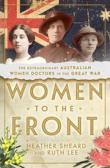AustLit
Latest Issues
AbstractHistoryArchive Description
'At the outbreak of World War I, 129 women were registered as medical practitioners in Australia, and many of them were eager to contribute their skills and expertise to the war effort. For the military establishment, however, the notion of women doctors serving on the battlefield was unthinkable. Undaunted, at least twenty-four Australian women doctors ignored official military policy and headed to the frontlines.
'This book explores the stories of the Australian women who served as surgeons, pathologists, anaesthetists and medical officers between 1914 and 1919. Despite saving hundreds of lives, their experiences are almost totally absent from official military records, both in Australia and Great Britain, and their achievements have remained invisible for over a century. Until now.
'Heather Sheard and Ruth Lee have compiled a fascinating and meticulously researched account of the Great War, seen through the eyes of these women and their essential work. From the Eastern to the Western Fronts, to Malta, and to London, we bear witness to the terrible conditions, the horrific injuries, the constant danger, and above all, the skill and courage displayed by this group of remarkable Australians. Women to the Front is a war story unlike any other.'
Source: Publisher's blurb.
Publication Details of Only Known VersionEarliest 2 Known Versions of
Works about this Work
-
Alexandra McKinnon Review of Heather Sheard and Ruth Lee, Women to the Front : The Extraordinary Australian Women Doctors of the Great War
2020
single work
review
— Appears in: Australian Journal of Biography and History , April no. 3 2020; (p. 179-183)
— Review of Women to the Front : The Extraordinary Australian Women Doctors in the Great War 2019 selected work biography 'On the night of 29 March 1918, Dr Phoebe Chapple saw the world explode in flames. She had been inspecting a Women’s Auxiliary Army Corps camp near Abbeville in France when the site came under fire from a German aerial bombardment. Chapple and 40 other women were sheltering in a trench when a direct hit killed eight women and mortally wounded a ninth. Chapple worked for hours in the destroyed camp, tending to the wounded in the dark. For ‘gallantry and devotion to duty’ during the attack, Chapple was awarded the Military Medal, making her the first woman doctor to receive the award. Chapple had enlisted in England with the Royal Army Medical Corps (RAMC) in 1917 as she was ineligible to join the Australian forces. At the outbreak of hostilities in 1914, women doctors were seen as unsuitable for active service in England, too. Women were allowed to serve as nurses and in a number of auxiliary roles, until the unceasing swell of wounded from the Western Front prompted the RAMC to reluctantly allow women medical practitioners into its ranks. Chapple was among dozens of women doctors who served in World War I, and who have largely been forgotten by history.' (Introduction) -
Battles on More Than One Front
2019
single work
review
— Appears in: The Weekend Australian , 6 April 2019; (p. 18)
— Review of Women to the Front : The Extraordinary Australian Women Doctors in the Great War 2019 selected work biography'Vera Scantlebury waved goodbye to her family as the HMTS Morea set sail from Port Melbourne pier in 1914. The preceding year, she had graduated with a medical degree from the University of Melbourne and won a position as a junior resident medical officer at Melbourne Hospital.' (Introduction)
-
Battles on More Than One Front
2019
single work
review
— Appears in: The Weekend Australian , 6 April 2019; (p. 18)
— Review of Women to the Front : The Extraordinary Australian Women Doctors in the Great War 2019 selected work biography'Vera Scantlebury waved goodbye to her family as the HMTS Morea set sail from Port Melbourne pier in 1914. The preceding year, she had graduated with a medical degree from the University of Melbourne and won a position as a junior resident medical officer at Melbourne Hospital.' (Introduction)
-
Alexandra McKinnon Review of Heather Sheard and Ruth Lee, Women to the Front : The Extraordinary Australian Women Doctors of the Great War
2020
single work
review
— Appears in: Australian Journal of Biography and History , April no. 3 2020; (p. 179-183)
— Review of Women to the Front : The Extraordinary Australian Women Doctors in the Great War 2019 selected work biography 'On the night of 29 March 1918, Dr Phoebe Chapple saw the world explode in flames. She had been inspecting a Women’s Auxiliary Army Corps camp near Abbeville in France when the site came under fire from a German aerial bombardment. Chapple and 40 other women were sheltering in a trench when a direct hit killed eight women and mortally wounded a ninth. Chapple worked for hours in the destroyed camp, tending to the wounded in the dark. For ‘gallantry and devotion to duty’ during the attack, Chapple was awarded the Military Medal, making her the first woman doctor to receive the award. Chapple had enlisted in England with the Royal Army Medical Corps (RAMC) in 1917 as she was ineligible to join the Australian forces. At the outbreak of hostilities in 1914, women doctors were seen as unsuitable for active service in England, too. Women were allowed to serve as nurses and in a number of auxiliary roles, until the unceasing swell of wounded from the Western Front prompted the RAMC to reluctantly allow women medical practitioners into its ranks. Chapple was among dozens of women doctors who served in World War I, and who have largely been forgotten by history.' (Introduction)




